2004 ISUZU TF SERIES fuel pump
[x] Cancel search: fuel pumpPage 1549 of 4264
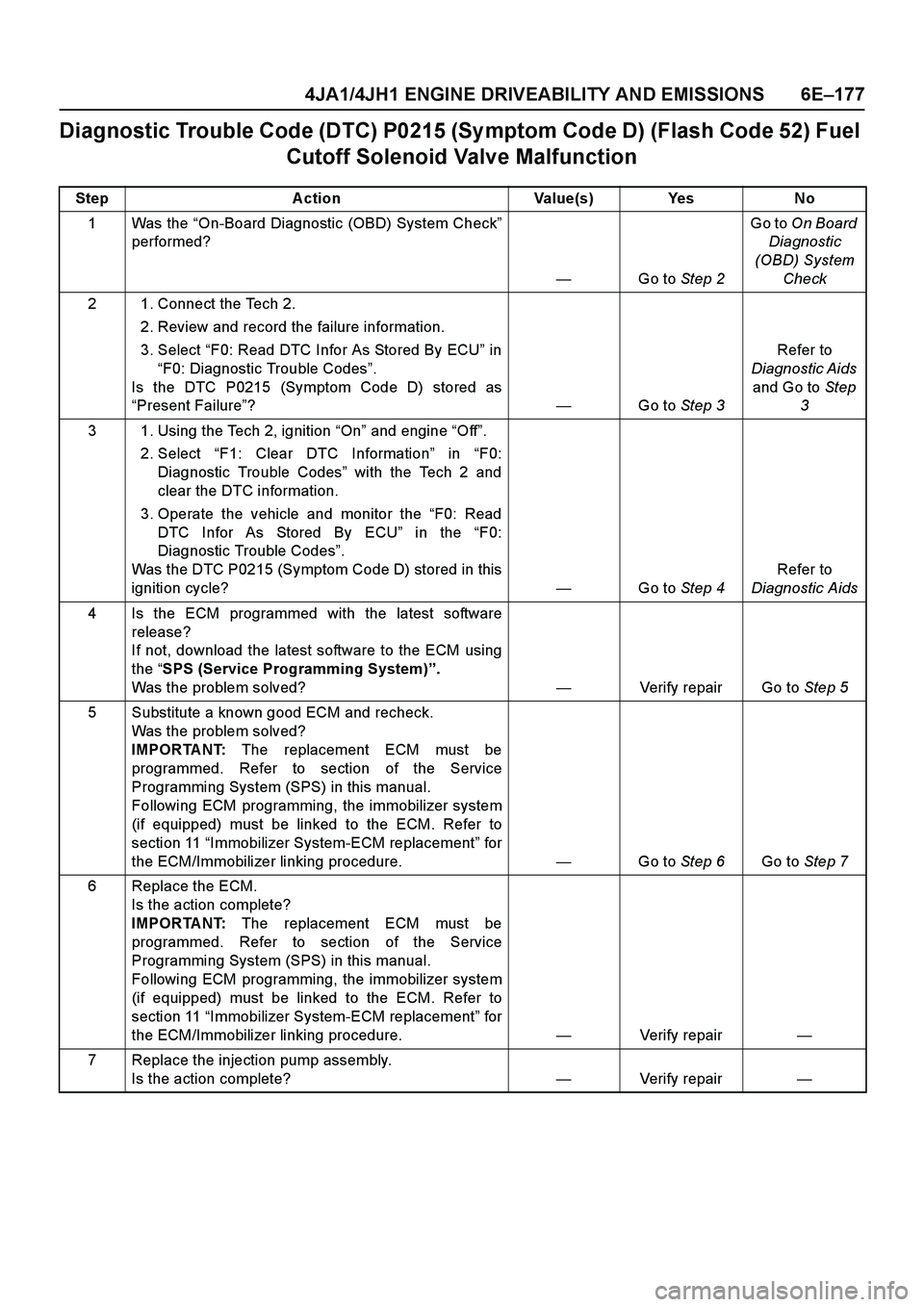
4JA1/4JH1 ENGINE DRIVEABILITY AND EMISSIONS 6E–177
Diagnostic Trouble Code (DTC) P0215 (Sy mptom Code D) (Flash Code 52) Fuel
Cutoff Solenoid Valve Malfunction
Step Action Value(s) Yes No
1Was the “On-Board Diagnostic (OBD) System Check”
performed?
—Go to Step 2Go to On Board
Diagnostic
(OBD) System
Check
2 1. Connect the Tech 2.
2. Review and record the failure information.
3. Select “F0: Read DTC Infor As Stored By ECU” in
“F0: Diagnostic Trouble Codes”.
Is the DTC P0215 (Symptom Code D) stored as
“Present Failure”?—Go to Step 3Refer to
Diagnostic Aids
and Go to Step
3
3 1. Using the Tech 2, ignition “On” and engine “Off”.
2. Select “F1: Clear DTC Information” in “F0:
Diagnostic Trouble Codes” with the Tech 2 and
clear the DTC information.
3. Operate the vehicle and monitor the “F0: Read
DTC Infor As Stored By ECU” in the “F0:
Diagnostic Trouble Codes”.
Was the DTC P0215 (Symptom Code D) stored in this
ignition cycle?—Go to Step 4Refer to
Diagnostic Aids
4 Is the ECM programmed with the latest software
release?
If not, download the latest software to the ECM using
the “SPS (Service Programming System)”.
Was the problem solved?—Verify repair Go to Step 5
5 Substitute a known good ECM and recheck.
Was the problem solved?
IMPORTANT: The replacement ECM must be
programmed. Refer to section of the Service
Programming System (SPS) in this manual.
Following ECM programming, the immobilizer system
(if equipped) must be linked to the ECM. Refer to
section 11 “Immobilizer System-ECM replacement” for
the ECM/Immobilizer linking procedure. —Go to Step 6Go to Step 7
6 Replace the ECM.
Is the action complete?
IMPORTANT: The replacement ECM must be
programmed. Refer to section of the Service
Programming System (SPS) in this manual.
Following ECM programming, the immobilizer system
(if equipped) must be linked to the ECM. Refer to
section 11 “Immobilizer System-ECM replacement” for
the ECM/Immobilizer linking procedure.—Verify repair—
7 Replace the injection pump assembly.
Is the action complete?—Verify repair—
Page 1551 of 4264
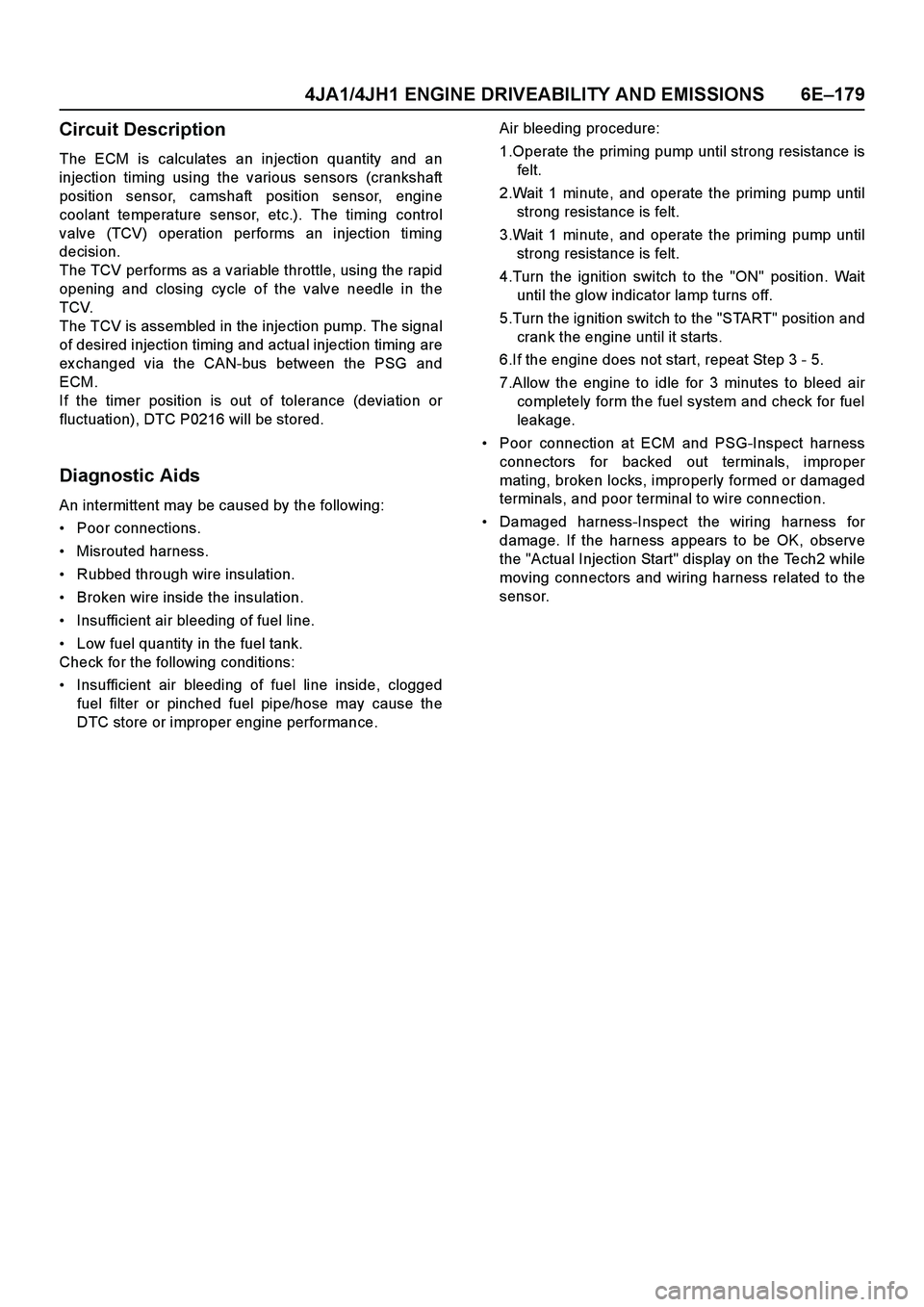
4JA1/4JH1 ENGINE DRIVEABILITY AND EMISSIONS 6E–179
Circuit Description
The ECM is calculates an injection quantity and an
injection timing using the various sensors (crankshaft
position sensor, camshaft position sensor, engine
coolant temperature sensor, etc.). The timing control
valve (TCV) operation performs an injection timing
decision.
The TCV performs as a variable throttle, using the rapid
opening and closing cycle of the valve needle in the
TCV.
The TCV is assembled in the injection pump. The signal
of desired injection timing and actual injection timing are
ex changed via the CAN-bus between the PSG and
ECM.
If the timer position is out of tolerance (deviation or
fluctuation), DTC P0216 will be stored.
Diagnostic Aids
An intermittent may be caused by the following:
Poor connections.
Misrouted harness.
Rubbed through wire insulation.
Broken wire inside the insulation.
Insufficient air bleeding of fuel line.
Low fuel quantity in the fuel tank.
Check for the following conditions:
Insufficient air bleeding of fuel line inside, clogged
fuel filter or pinched fuel pipe/hose may cause the
DTC store or improper engine performance.Air bleeding procedure:
1.Operate the priming pump until strong resistance is
felt.
2.Wait 1 minute, and operate the priming pump until
strong resistance is felt.
3.Wait 1 minute, and operate the priming pump until
strong resistance is felt.
4.Turn the ignition switch to the "ON" position. Wait
until the glow indicator lamp turns off.
5.Turn the ignition switch to the "START" position and
crank the engine until it starts.
6.If the engine does not start, repeat Step 3 - 5.
7.Allow the engine to idle for 3 minutes to bleed air
completely form the fuel system and check for fuel
leakage.
Poor connection at ECM and PSG-Inspect harness
connectors for backed out terminals, improper
mating, broken locks, improperly formed or damaged
terminals, and poor terminal to wire connection.
Damaged harness-Inspect the wiring harness for
damage. If the harness appears to be OK, observe
the "Actual Injection Start" display on the Tech2 while
moving connectors and wiring harness related to the
sensor.
Page 1552 of 4264
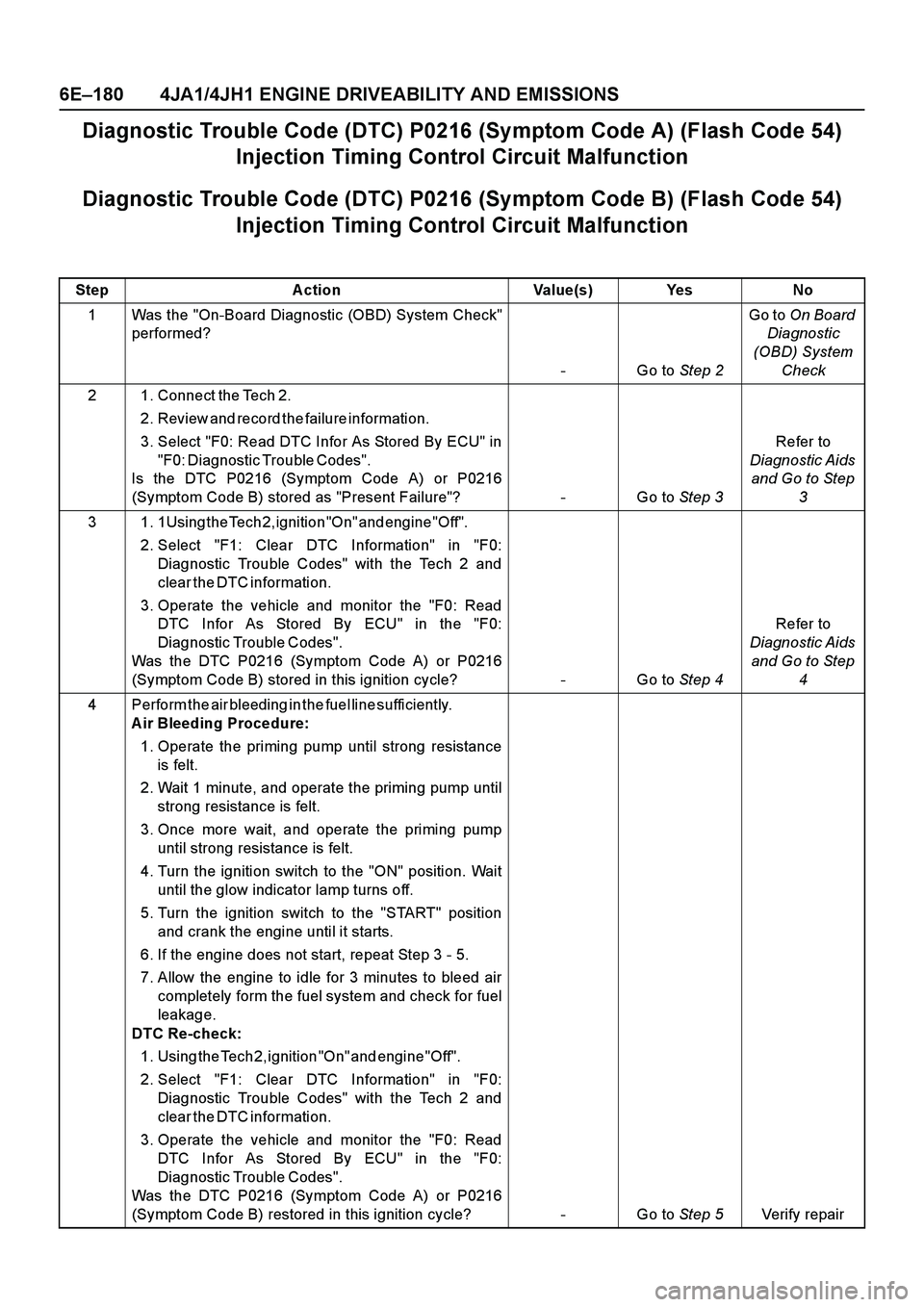
6E–180 4JA1/4JH1 ENGINE DRIVEABILITY AND EMISSIONS
Diagnostic Trouble Code (DTC) P0216 (Symptom Code A) (Flash Code 54)
Injection Timing Control Circuit Malfunction
Diagnostic Trouble Code (DTC) P0216 (Symptom Code B) (Flash Code 54)
Injection Timing Control Circuit Malfunction
Step Action Value(s) Yes No
1 Was the "On-Board Diagnostic (OBD) System Check"
performed?
-Go to Step 2Go to On Board
Diagnostic
(OBD) System
Check
2 1. Connect the Tech 2.
2. Review and record the failure information.
3. Select "F0: Read DTC Infor As Stored By ECU" in
"F0: Diagnostic Trouble Codes".
Is the DTC P0216 (Symptom Code A) or P0216
(Symptom Code B) stored as "Present Failure"? - Go to Step 3Refer to
Diagnostic Aids
and Go to Step
3
3 1. 1Using the Tech 2, ignition "On" and engine "Off".
2. Select "F1: Clear DTC Information" in "F0:
Diagnostic Trouble Codes" with the Tech 2 and
c l e a r t h e D T C i n f o r m a t i o n .
3. Operate the vehicle and monitor the "F0: Read
DTC Infor As Stored By ECU" in the "F0:
Diagnostic Trouble Codes".
Was the DTC P0216 (Symptom Code A) or P0216
(Symptom Code B) stored in this ignition cycle? - Go to Step 4Refer to
Diagnostic Aids
and Go to Step
4
4 Perform the air bleeding in the fuel line sufficiently.
A ir Bleeding Procedure:
1. Operate the priming pump until strong resistance
is felt.
2. Wait 1 minute, and operate the priming pump until
strong resistance is felt.
3. Once more wait, and operate the priming pump
until strong resistance is felt.
4. Turn the ignition switch to the "ON" position. Wait
until the glow indicator lamp turns off.
5. Turn the ignition switch to the "START" position
and crank the engine until it starts.
6. If the engine does not start, repeat Step 3 - 5.
7. Allow the engine to idle for 3 minutes to bleed air
completely form the fuel system and check for fuel
leakage.
DTC Re-check:
1. Using the Tech 2, ignition "On" and engine "Off".
2. Select "F1: Clear DTC Information" in "F0:
Diagnostic Trouble Codes" with the Tech 2 and
c l e a r t h e D T C i n f o r m a t i o n .
3. Operate the vehicle and monitor the "F0: Read
DTC Infor As Stored By ECU" in the "F0:
Diagnostic Trouble Codes".
Was the DTC P0216 (Symptom Code A) or P0216
(Symptom Code B) restored in this ignition cycle? - Go to Step 5Verify repair
Page 1553 of 4264
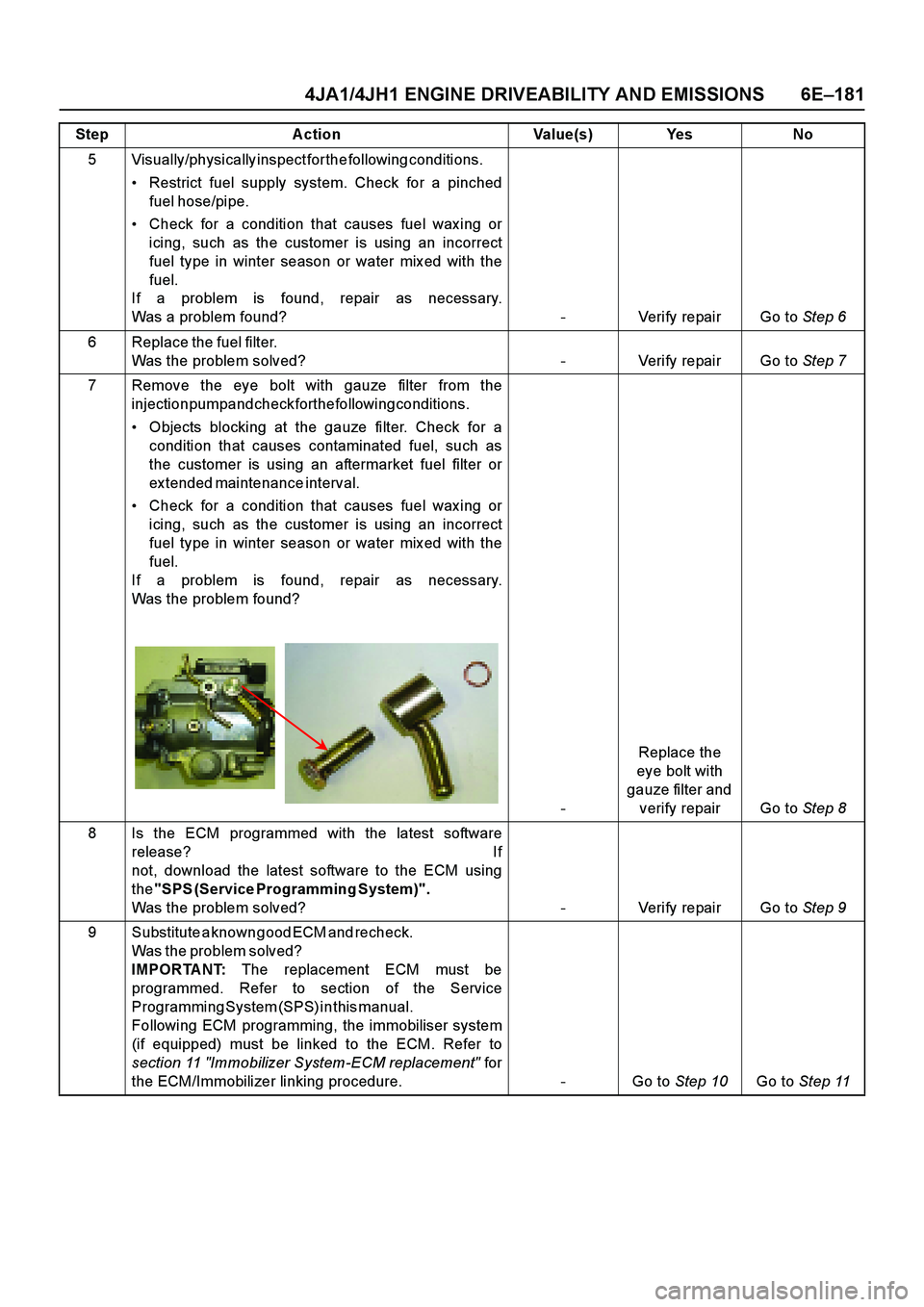
4JA1/4JH1 ENGINE DRIVEABILITY AND EMISSIONS 6E–181
5 V i s u a l l y / p h y s i c a l l y i n s p e c t f o r t h e f o l l o w i n g c o n d i t i o n s .
Restrict fuel supply system. Check for a pinched
fuel ho se /pi pe.
Check for a condition that causes fuel wax ing or
icing, such as the customer is using an incorrect
fuel type in winter season or water mix ed with the
f u e l.
If a problem is found, repair as necessary.
Was a problem found? - Verify repair Go to Step 6
6 Replace the fuel fi lt er.
Was the problem solved? - Verify repair Go to Step 7
7 Remove the eye bolt with gauze filter from the
injection pump and check for the following conditions.
Objects blocking at the gauze filter. Check for a
condition that causes contaminated fuel, such as
the customer is using an aftermarket fuel filter or
ex tended maintenance interval.
Check for a condition that causes fuel wax ing or
icing, such as the customer is using an incorrect
fuel type in winter season or water mix ed with the
f u e l.
If a problem is found, repair as necessary.
Was the problem found?
-Replace the
eye bolt with
gauze filter and
verify repair Go to Step 8
8 Is the ECM programmed with the latest software
release? If
not, download the latest software to the ECM using
the "SPS (Service Programming System)".
Was the problem solved? - Verify repair Go to Step 9
9 Substitute a known good ECM and recheck.
Was the problem solved?
IMPORTANT: The replacement ECM must be
programmed. Refer to section of the Service
Programming System (SPS) in this manual.
Following ECM programming, the immobiliser system
(if equipped) must be linked to the ECM. Refer to
section 11 "Immobilizer System-ECM replacement" for
the ECM/Immobilizer linking procedure. - Go to Step 10Go to Step 11 Step Action Value(s) Yes No
Page 1556 of 4264

6E–184 4JA1/4JH1 ENGINE DRIVEABILITY AND EMISSIONS
Condition for setting the DTC and action taken when the DTC sets
Circuit description
The ECM monitors altitude from the barometric
pressure sensor. To apply specified vacuum pressure to
the turbocharger wastegate valve, ECM sends control
signal to the wastegate control solenoid depending on
altitude.
Then, apply vacuum pressure to the turbocharger
wastegate valve is monitored by the ECM form the
vacuum pressure sensor output signal. The ECM
controls wastegate control solenoid based on signal
from vacuum pressure sensor output.
If the vacuum pressure sensor detected vacuum
pressure is excessively low or high due to faulty vacuum
line, vacuum pump or turbocharger wastegate valve,
DTC P0243 (Symptom Code 3), P0243 (Symptom Code
5) or P0243 (Symptom Code 6) will be stored.
If the wastegate control solenoid circuit is open or short
to ground circuit, DTC P0243 (Symptom Code 4) will be
stored.
If the wastegate control solenoid circuit is short to
voltage circuit, DTC P0243 (Symptom Code 8) will be
stored.
Diagnostic Aids
An intermittent may be caused by the following:
Poor connections.
Misrouted harness.
Rubbed through wire insulation.
Broken wire inside insulation.
Turbocharger wastegate valve sticking or broken.
Misrouted vacuum hose.
Faulty vacuum pump or regulating valve.
Check for the following conditions:
Poor connection at ECM-Inspect harness connectors
for backed out terminals, improper mating, broken
locks, improperly formed or damaged terminals, and
poor terminal to wire connection.
Damaged harness-Inspect the wiring harness for
damage. If the harness appears to be OK, observe
the DTC P0243 display on the Tech 2 while moving
connectors and wiring harnesses. A change in the
display will indicate the location of the fault.
Flash
CodeCode Symptom
CodeMIL DTC Name DTC Setting Condition Fail-Safe (Back Up)
64 P0243 3 ON Turbocharger Wastegate
So le no id "A" Ra nge/
Pe rfo rma nce1. Intake air temperature is
between -50 deg. C and
2 0 0 d e g . C .
2. Engine coolant
temperature is between -
50 deg. C and 150 deg.
C. 1. Fuel injection quantity is
r e d u c e d .
2. EGR EVRV becomes 10%
co nditio n.
4 ON Turbocharger Wastegate
So le no id "A" Lo w Wastegate control EVRV
circuit open or short to ground
circuit.1. Fuel injection quantity is
r e d u c e d .
2. EGR EVRV becomes 10%
c o n d i t i o n .
3. Wastegate control EVRV
be co mes 32% conditio n.
5 ON Turbocharger Wastegate
So le no id "A" Ra nge/
Pe rfo rma nce1. Intake air temperature is
between -50 deg. C and
2 0 0 d e g . C .
2. Engine coolant
temperature is between -
50 deg. C and 150 deg.
C. 1. Fuel injection quantity is
r e d u c e d .
2. EGR EVRV becomes 10%
co nditio n.
6 ON Turbocharger Wastegate
So le no id "A" Malfunctio n1. Engine coolant
temperature is between -
50 deg. C and 150 deg.
C .
2. EGR contro l EVRV 0%
co nditio n.
8 ON Turbocharger Wastegate
So le no id "A" HighWastegate control EVRV
circuit short to voltage circuit.1. Fuel injection quantity is
r e d u c e d .
2. EGR EVRV becomes 10%
c o n d i t i o n .
3. Wastegate control EVRV
be co mes 32% conditio n.
Page 1569 of 4264
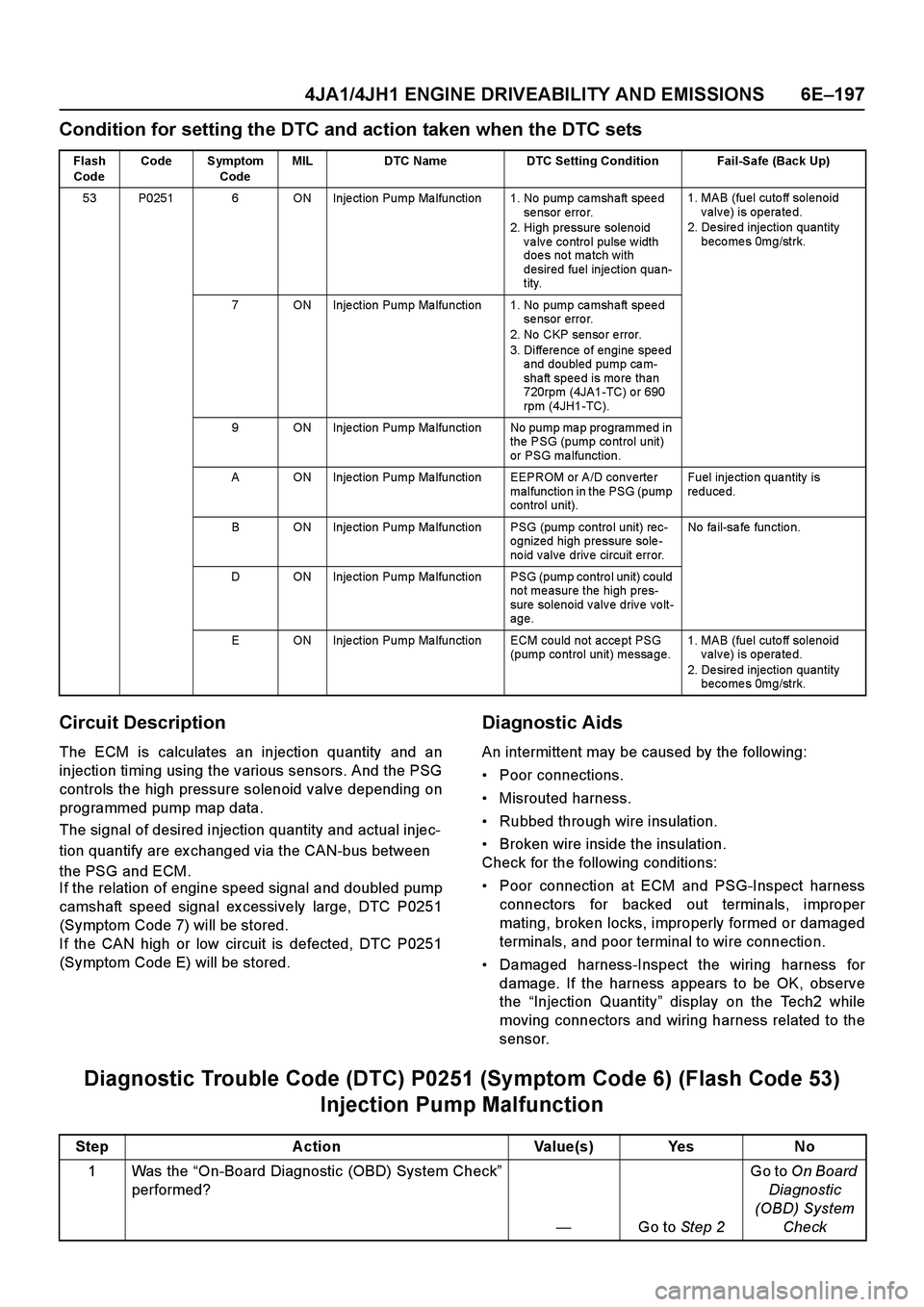
4JA1/4JH1 ENGINE DRIVEABILITY AND EMISSIONS 6E–197
Condition for setting the DTC and action taken when the DTC sets
Circuit Description
The ECM is calculates an injection quantity and an
injection timing using the various sensors. And the PSG
controls the high pressure solenoid valve depending on
programmed pump map data.
The signal of desired injection quantity and actual injec-
tion quantify are ex changed via the CAN-bus between
the PSG and ECM.
If the relation of engine speed signal and doubled pump
camshaft speed signal ex cessively large, DTC P0251
(Symptom Code 7) will be stored.
If the CAN high or low circuit is defected, DTC P0251
(Symptom Code E) will be stored.
Diagnostic Aids
An intermittent may be caused by the following:
Poor connections.
Misrouted harness.
Rubbed through wire insulation.
Broken wire inside the insulation.
Check for the following conditions:
Poor connection at ECM and PSG-Inspect harness
connectors for backed out terminals, improper
mating, broken locks, improperly formed or damaged
terminals, and poor terminal to wire connection.
Damaged harness-Inspect the wiring harness for
damage. If the harness appears to be OK, observe
the “Injection Quantity” display on the Tech2 while
moving connectors and wiring harness related to the
sensor.
Diagnostic Trouble Code (DTC) P0251 (Symptom Code 6) (Flash Code 53)
Injection Pump Malfunction
Flash
CodeCode Symptom
CodeMIL DTC Name DTC Setting Condition Fail-Safe (Back Up)
53 P0251 6 ON Injection Pump Malfunction 1. No pump camshaft speed
se nsor erro r.
2. High pressure solenoid
v a lv e co ntro l pulse w idth
doe s no t ma tch with
desired fuel injection quan-
tity. 1. MAB (fuel cutoff solenoid
valve) is operated.
2. Desired injection quantity
becomes 0mg/strk.
7 ON Injection Pump Malfunction 1. No pump camshaft speed
se nsor erro r.
2. No CKP senso r e rror.
3. Difference of engine speed
and doubled pump cam-
shaft speed is more than
720rpm (4JA1-TC) or 690
rpm (4JH1-TC).
9 ON Injection Pump Malfunction No pump map programmed in
the PSG (pump co ntrol unit)
or PSG malfunction.
A ON Injection Pump Malfunction EEPROM or A/D converter
malfunctio n in the PSG (pump
control unit).Fuel inje ctio n qua ntity is
reduced.
B ON Injection Pump Malfunction PSG (pump control unit) rec-
ognized high pressure sole -
noid valve drive circuit error.No fa il-sa fe fun ctio n.
D ON Injection Pump Malfunction PSG (pump control unit) could
no t me asure the high pres-
sure solenoid valve drive volt-
age.
E ON Injection Pump Malfunction ECM could not accept PSG
(pump co ntrol unit) messa ge.1. MAB (fuel cutoff solenoid
valve) is operated.
2. Desired injection quantity
becomes 0mg/strk.
Step Action Value(s) Yes No
1Was the “On-Board Diagnostic (OBD) System Check”
performed?
—Go to Step 2Go to On Board
Diagnostic
(OBD) System
Check
Page 1581 of 4264
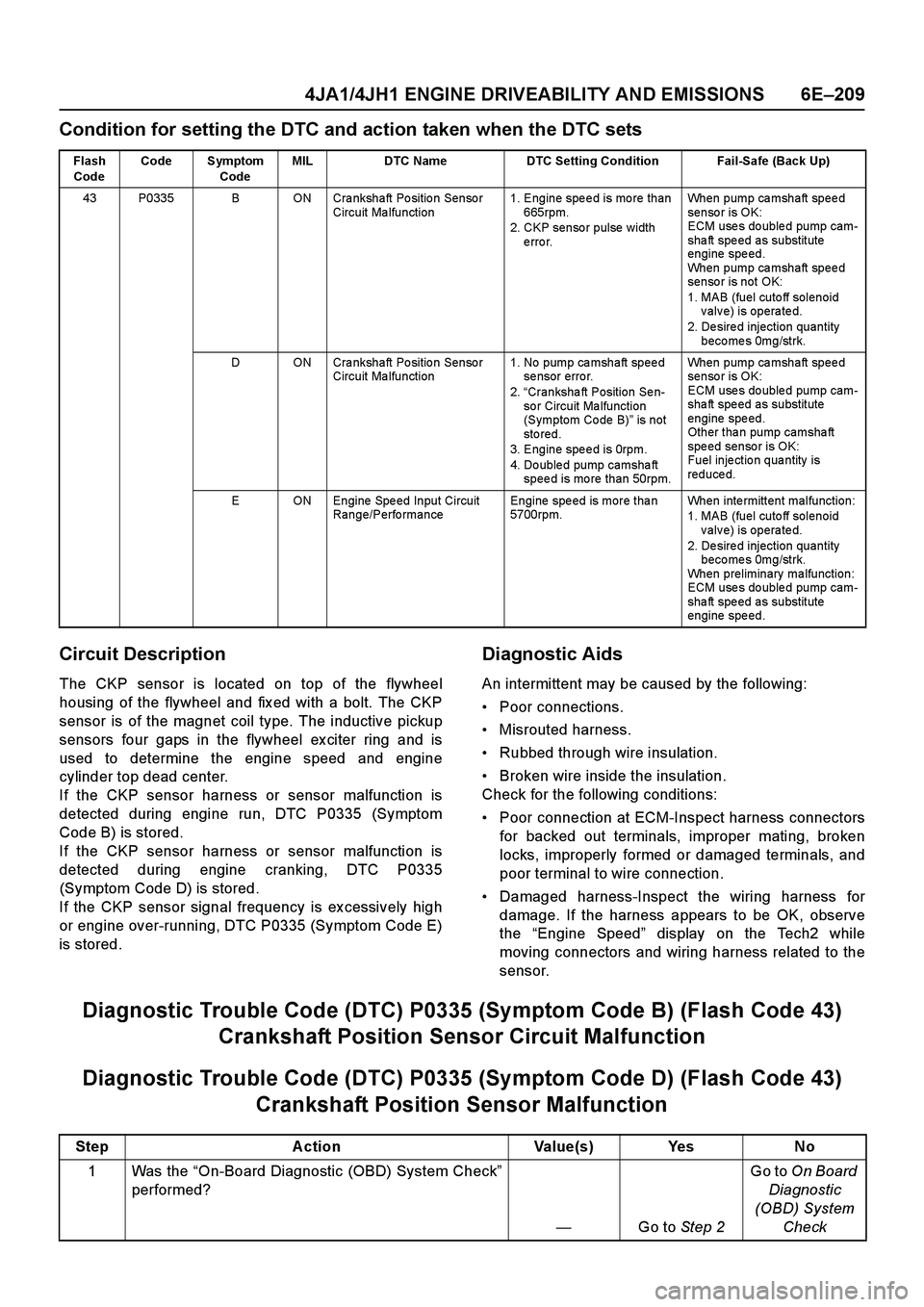
4JA1/4JH1 ENGINE DRIVEABILITY AND EMISSIONS 6E–209
Condition for setting the DTC and action taken when the DTC sets
Circuit Description
The CKP sensor is located on top of the flywheel
housing of the flywheel and fix ed with a bolt. The CKP
sensor is of the magnet coil type. The inductive pickup
sensors four gaps in the flywheel ex citer ring and is
used to determine the engine speed and engine
cylinder top dead center.
If the CKP sensor harness or sensor malfunction is
detected during engine run, DTC P0335 (Symptom
Code B) is stored.
If the CKP sensor harness or sensor malfunction is
detected during engine cranking, DTC P0335
(Symptom Code D) is stored.
If the CKP sensor signal frequency is ex cessively high
or engine over-running, DTC P0335 (Symptom Code E)
is stored.
Diagnostic Aids
An intermittent may be caused by the following:
Poor connections.
Misrouted harness.
Rubbed through wire insulation.
Broken wire inside the insulation.
Check for the following conditions:
Poor connection at ECM-Inspect harness connectors
for backed out terminals, improper mating, broken
locks, improperly formed or damaged terminals, and
poor terminal to wire connection.
Damaged harness-Inspect the wiring harness for
damage. If the harness appears to be OK, observe
the “Engine Speed” display on the Tech2 while
moving connectors and wiring harness related to the
sensor.
Diagnostic Trouble Code (DTC) P0335 (Symptom Code B) (Flash Code 43)
Crankshaft Position Sensor Circuit Malfunction
Diagnostic Trouble Code (DTC) P0335 (Symptom Code D) (Flash Code 43)
Crankshaft Position Sensor Malfunction
Flash
CodeCode Symptom
CodeMIL DTC Name DTC Setting Condition Fail-Safe (Back Up)
43 P0335 B ON Crankshaft Position Sensor
Circuit Ma lfunction1. Engine speed is more than
665rpm.
2. CKP sensor pulse width
e rro r.When pump camshaft speed
senso r is OK:
ECM use s do uble d pump cam-
sha ft spe ed as substitute
engine speed.
When pump camshaft speed
senso r is not OK:
1. MAB (fuel cutoff solenoid
valve) is operated.
2. Desired injection quantity
becomes 0mg/strk.
D ON Crankshaft Position Sensor
Circuit Ma lfunction1. No pump camshaft speed
se nsor erro r.
2.“Cranksha ft Position Se n-
so r Circuit Ma lfunction
(Symptom Code B)” is not
stored.
3. Engine speed is 0rpm.
4. Do uble d pump camsha ft
speed is more than 50rpm.When pump camshaft speed
senso r is OK:
ECM use s do uble d pump cam-
sha ft spe ed as substitute
engine speed.
Other tha n pump camsha ft
speed sensor is OK:
Fuel inje ctio n qua ntity is
reduced.
E ON Engine Speed Input Circuit
Range/PerformanceEngine spe ed is more tha n
5700rpm.When intermittent malfunction:
1. MAB (fuel cutoff solenoid
valve) is operated.
2. Desired injection quantity
becomes 0mg/strk.
When preliminary malfunction:
ECM use s do uble d pump cam-
sha ft spe ed as substitute
engine speed.
Step Action Value(s) Yes No
1Was the “On-Board Diagnostic (OBD) System Check”
performed?
—Go to Step 2Go to On Board
Diagnostic
(OBD) System
Check
Page 1674 of 4264
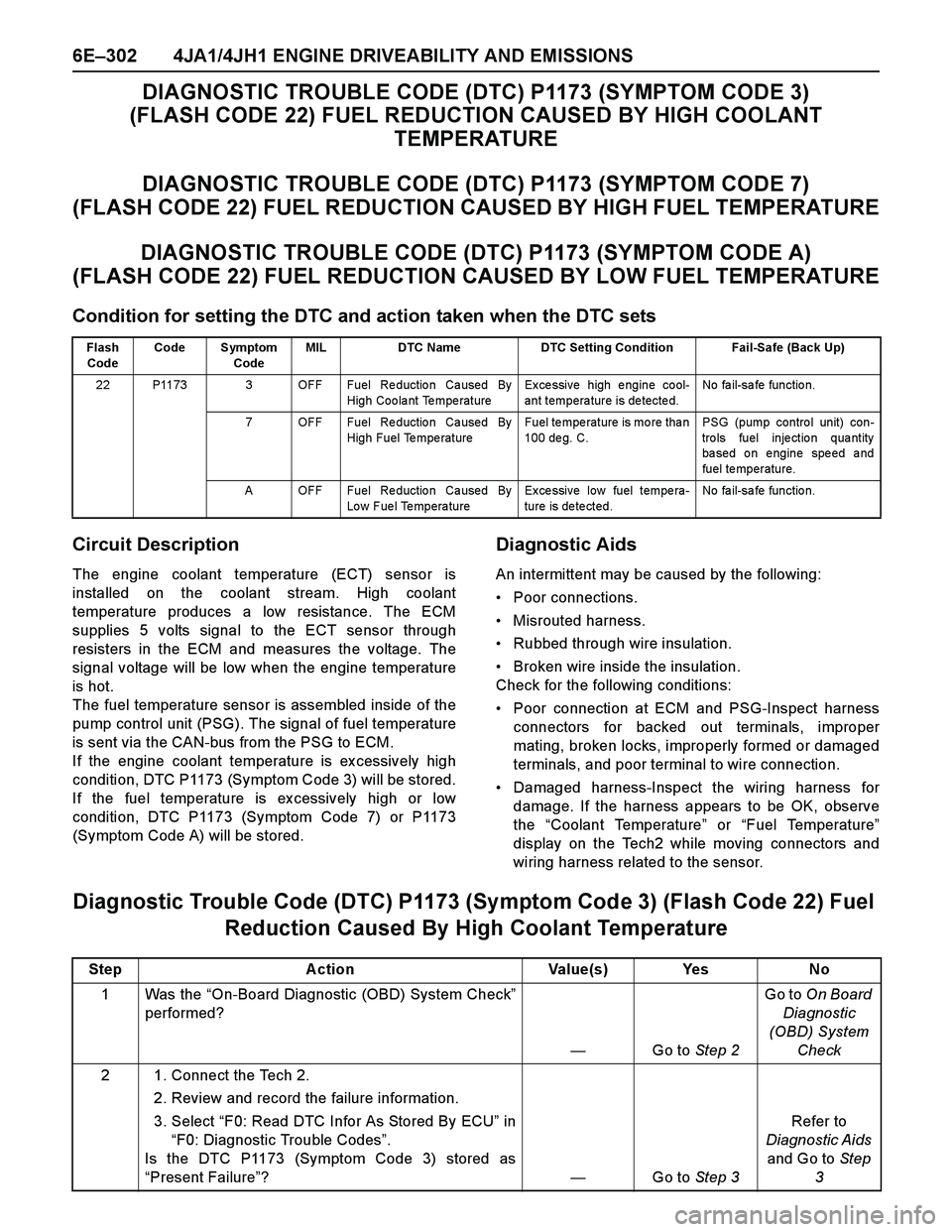
6E–302 4JA1/4JH1 ENGINE DRIVEABILITY AND EMISSIONS
DIAGNOSTIC TROUBLE CODE (DTC) P1173 (SYMPTOM CODE 3)
(FLASH CODE 22) FUEL REDUCTION CAUSED BY HIGH COOLANT
TEMPERATURE
DIAGNOSTIC TROUBLE CODE (DTC) P1173 (SYMPTOM CODE 7)
(FLASH CODE 22) FUEL REDUCTION CAUSED BY HIGH FUEL TEMPERATURE
DIAGNOSTIC TROUBLE CODE (DTC) P1173 (SYMPTOM CODE A)
(FLASH CODE 22) FUEL REDUCTION CAUSED BY LOW FUEL TEMPERATURE
Condition for setting the DTC and action taken when the DTC sets
Circuit Description
The engine coolant temperature (ECT) sensor is
installed on the coolant stream. High coolant
temperature produces a low resistance. The ECM
supplies 5 volts signal to the ECT sensor through
resisters in the ECM and measures the voltage. The
signal voltage will be low when the engine temperature
is hot.
The fuel temperature sensor is assembled inside of the
pump control unit (PSG). The signal of fuel temperature
is sent via the CAN-bus from the PSG to ECM.
If the engine coolant temperature is ex cessively high
condition, DTC P1173 (Symptom Code 3) will be stored.
If the fuel temperature is ex cessively high or low
condition, DTC P1173 (Symptom Code 7) or P1173
(Symptom Code A) will be stored.
Diagnostic Aids
An intermittent may be caused by the following:
Poor connections.
Misrouted harness.
Rubbed through wire insulation.
Broken wire inside the insulation.
Check for the following conditions:
Poor connection at ECM and PSG-Inspect harness
connectors for backed out terminals, improper
mating, broken locks, improperly formed or damaged
terminals, and poor terminal to wire connection.
Damaged harness-Inspect the wiring harness for
damage. If the harness appears to be OK, observe
the “Coolant Temperature” or “Fuel Temperature”
display on the Tech2 while moving connectors and
wiring harness related to the sensor.
Diagnostic Trouble Code (DTC) P1173 (Symptom Code 3) (Flash Code 22) Fuel
Reduction Caused By High Coolant Temperature
Flash
CodeCode Symptom
CodeMIL DTC Name DTC Setting Condition Fail-Safe (Back Up)
22 P1173 3 OFF Fuel Reduction Caused By
High Coolant TemperatureExcessive high engine cool-
ant temperature is detected.No fa il-sa fe fun ctio n.
7 OFF Fuel Re ductio n Ca used By
High Fuel TemperatureFuel te mpe rature is mo re tha n
100 de g. C.PSG (pump contro l unit) con-
tro ls fuel inje ctio n qua ntity
based on engine speed and
fuel temperature.
A OFF Fuel Re ductio n Ca used By
Low Fuel TemperatureExcessive low fuel tempera-
ture is de te cted.No fa il-sa fe fun ctio n.
Step Action Value(s) Yes No
1Was the “On-Board Diagnostic (OBD) System Check”
performed?
—Go to Step 2Go to On Board
Diagnostic
(OBD) System
Check
2 1. Connect the Tech 2.
2. Review and record the failure information.
3. Select “F0: Read DTC Infor As Stored By ECU” in
“F0: Diagnostic Trouble Codes”.
Is the DTC P1173 (Symptom Code 3) stored as
“Present Failure”?—Go to Step 3Refer to
Diagnostic Aids
and Go to Step
3